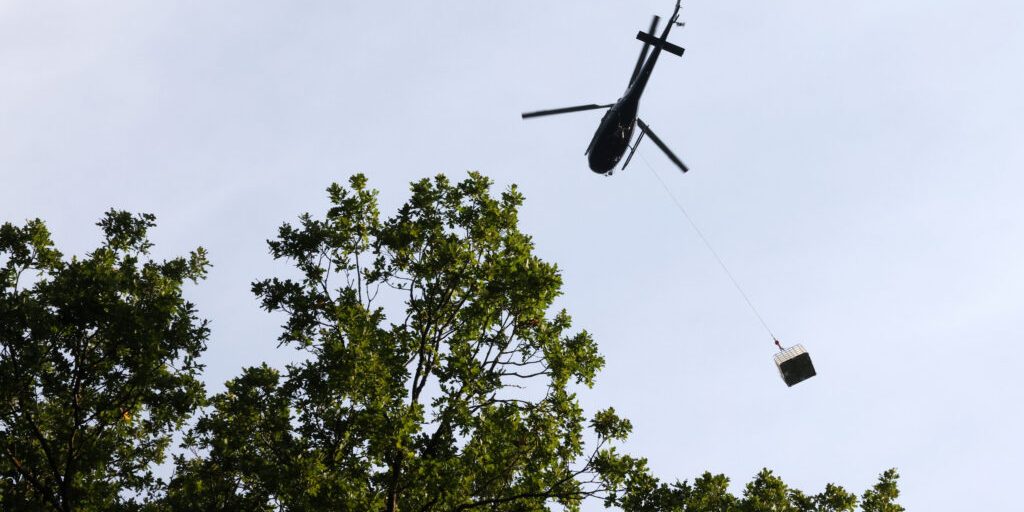The advent of helicopter tree trimming marks a revolutionary shift in landscape management, combining high-end technology with environmental consciousness. This method, employing helicopters for trimming trees, particularly in challenging locations, has transformed the way we approach vegetation management.
Helicopter Tree Trimming
Helicopter tree trimming involves using specially equipped helicopters to trim trees, especially around power lines or in hard-to-reach areas. This method is a game-changer, especially in landscape management and utility maintenance.
The Evolution of Tree Trimming Methods
Tree trimming has evolved from manual labor-intensive processes to more sophisticated methods, including the use of cranes and bucket trucks. The integration of helicopters is the latest advancement, providing unprecedented efficiency and accessibility.
Why Helicopter Tree Trimming is Gaining Popularity
Its rising popularity is due to its effectiveness in reducing the time, labor, and overall cost of traditional tree trimming methods. Additionally, it minimizes environmental impact and improves safety in dangerous or inaccessible areas.
The Technology Behind Helicopter Tree Trimming
This cutting-edge method is a result of significant technological advancements in both aviation and arboriculture.
Helicopters Used in Tree Trimming
The helicopters are specially designed for agility and stability, and equipped with advanced navigation systems to ensure precision in operations.
Cutting Equipment and Tools
The cutting tools used are technologically advanced, often featuring long, high-speed saws or shears capable of quickly cutting through thick branches.
Safety and Navigation Technologies
Modern helicopters are outfitted with advanced safety features and navigation technologies, including GPS and collision avoidance systems, to ensure safe and efficient operations.
Benefits of Helicopter Tree Trimming
Helicopter tree trimming offers a multitude of benefits, making it an increasingly popular choice.
Speed and Efficiency
This method is incredibly fast and capable of trimming large areas in a fraction of the time it would take using ground-based methods.
Access to Remote Areas
Helicopters can access virtually any location, regardless of how remote or difficult the terrain is, providing an advantage over traditional methods.
Reduced Ground Disturbance
Since the operation is conducted from the air, there is minimal disturbance to the ground, protecting the soil structure and surrounding vegetation.
Challenges and Limitations
Despite its advantages, helicopter tree trimming comes with its own set of challenges.
Cost Considerations
The initial cost can be higher due to the expense of operating helicopters and specialized equipment. However, these costs are often balanced out by the speed and efficiency of the operation.
Weather Dependencies
Operations are highly sensitive to weather conditions. Strong winds, rain, or poor visibility can delay or halt trimming activities.
Skill and Experience Requirements
This method requires highly skilled pilots and ground crew, who need specialized training in arboriculture and aviation.
Environmental Impact
The environmental impact of helicopter tree trimming is a critical aspect to consider.
Effects on Local Flora and Fauna
Although the method reduces soil disturbance, the noise and emissions from helicopters can impact wildlife and surrounding ecosystems.
Comparison with Traditional Tree Trimming Methods
Compared to ground-based methods, helicopter tree trimming is less disruptive, especially in sensitive or protected areas.
Mitigating Environmental Footprint
Operators often use strategies to minimize environmental impact, such as using biofuels, scheduling operations to avoid disrupting wildlife, and ensuring compliance with environmental regulations.
Safety Protocols in Helicopter Tree Trimming
Safety is a paramount concern in helicopter tree-trimming operations.
Training and Certification for Pilots and Ground Crew
Extensive training and certification are mandatory for all personnel involved, ensuring they are equipped to handle the complexities of aerial tree trimming.
Equipment Maintenance and Checks
Regular maintenance and rigorous safety checks of helicopters and equipment are essential to prevent accidents and ensure operational safety.
Emergency Procedures
Comprehensive emergency plans are in place to address any potential incidents, ensuring rapid and effective response.
Case Studies: Successful Helicopter Tree Trimming Projects
Numerous successful projects worldwide showcase the effectiveness of helicopter tree trimming.
Large-Scale Urban Projects
In urban environments, this method has been pivotal in maintaining tree health around power lines, significantly reducing power outages and fire hazards.
Wilderness and Forest Area Management
It has proven invaluable in managing forested areas, controlling invasive species, and mitigating wildfire risks.
Impact on Local Communities and Ecosystems
These projects have demonstrated positive outcomes, including improved safety for communities and enhanced preservation of natural habitats.
Legal and Regulatory Aspects
The practice of helicopter tree trimming is governed by several legal and regulatory frameworks.
Obtaining Permissions and Licenses
Operators must secure appropriate permissions and adhere to aviation regulations, ensuring safe and legal operations.
Compliance with Environmental Laws
Strict compliance with environmental laws is crucial, particularly when operating in ecologically sensitive areas.
Working within Airspace Regulations
Coordination with aviation authorities is essential for complying with airspace regulations and ensuring the safety of other air traffic.
Future of Helicopter Tree Trimming
The future of this method is promising, with ongoing innovations and potential for wider applications.
Technological Advancements
Continuous advancements in aviation and tree-trimming technologies are expected further to enhance the efficiency and safety of helicopter tree trimming.
Expanding Applications and Uses
The method’s potential extends beyond traditional applications, with possibilities in disaster relief, urban development, and environmental conservation.
Predictions and Trends
Industry trends indicate an increasing adoption of helicopter tree trimming, driven by technological advancements and a growing emphasis on sustainable practices.
How to Choose a Helicopter Tree Trimming Service
Selecting the right service provider is crucial for the success and safety of your project.
Evaluating Expertise and Experience
Ensure the service provider has a solid track record and the necessary expertise in both aviation and arboriculture.
Understanding Cost Structures
Familiarize yourself with the cost breakdown, including operational, maintenance, and safety-related expenses.
Assessing Safety and Environmental Records
Opt for providers with strong safety protocols and a commitment to environmental sustainability.
Frequently Asked Questions (FAQs)
What is helicopter tree trimming?
Helicopter tree trimming is an innovative method of trimming trees using a helicopter equipped with specialized cutting tools. It is primarily used for managing vegetation in difficult-to-reach areas, such as around power lines or in rugged terrains.
How does helicopter tree trimming work?
A helicopter, equipped with aerial saws or other cutting tools, flies close to the trees that need trimming. The pilot maneuvers the helicopter while the ground crew assists in guiding and ensuring safety, allowing precise and efficient cutting.
What are the main benefits of using helicopter tree trimming?
The primary benefits include the ability to access remote or difficult terrains, speed and efficiency in completing large-scale projects, minimal ground disturbance, and enhanced safety in hazardous areas.
Is helicopter tree trimming environmentally friendly?
While it does involve fuel consumption and noise, helicopter tree trimming is considered more environmentally friendly than traditional methods in certain aspects. It reduces the need for heavy ground equipment, thus minimizing soil compaction and disturbance to the ecosystem.
How safe is helicopter tree trimming?
Helicopter tree trimming is generally safe when conducted by trained and certified professionals. Stringent safety protocols, regular equipment checks, and advanced navigation technology contribute to the high safety standards of this method.
What kind of training do helicopter tree-trimming operators need?
Operators need specialized training in both aviation and arboriculture. Pilots must be trained in precision flying, while ground crew needs to understand tree biology and trimming techniques, in addition to safety procedures.
How much does helicopter tree trimming cost?
The cost varies depending on the project’s scale, location, and complexity. While it may be more expensive than traditional methods, its efficiency and ability to handle large-scale projects quickly can make it cost-effective in the long run.
Can helicopter tree trimming be used in urban areas?
Yes, it can be used in urban areas, especially for managing trees around power lines and other infrastructure. However, extra precautions are taken to ensure safety and minimize disruptions.
What are the limitations of helicopter tree trimming?
The main limitations include its dependence on weather conditions, the need for skilled operators, and higher initial costs. It may also not be suitable for small-scale or precision trimming projects.
Where can I find a reliable helicopter tree-trimming service?
To find a reliable service, look for companies with a proven track record, certified and trained personnel, and strong safety and environmental policies. Checking customer reviews and asking for referrals can also be helpful.
Conclusion
In conclusion, helicopter tree trimming stands as a remarkable innovation in landscape management. Its blend of speed, efficiency, and reduced environmental impact makes it a valuable tool in modern arboriculture and utility management. As technology progresses, we can expect this method to become even more prevalent, continuing to balance technological advancement with ecological responsibility.





